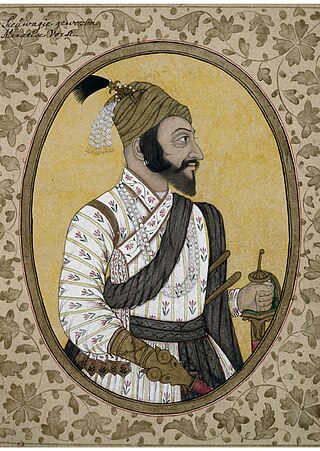Related Research Articles

Shivaji I was an Indian ruler and a member of the Bhonsle dynasty. Shivaji carved out his own independent kingdom from the Sultanate of Bijapur that formed the genesis of the Maratha Confederacy.

Kolhapur is a city on the banks of the Panchganga River in the southern part of the Indian state of Maharashtra.

Chhatrapati is a royal title from Sanskrit used to denote a king. The word "Chhatrapati" is a Sanskrit language compound word of chhatra and pati (master/lord/ruler). This title was used by the House of Bhonsle, between 1674 and 1818, as the heads of state of the Maratha Confederacy.

Shahu I was the fifth Chhatrapati of the Maratha Confederacy founded by his grandfather, Shivaji I. He was born into the Bhonsle family, and was the son of Sambhaji I and Yesubai. At a young age, he was taken into custody at the Siege of Raigad by Mughal emperor Aurangzeb, and held captive. He was released from captivity after the death of Aurangzeb in the hope of engineering an internecine struggle among the Maratha factions of Tarabai and Shahu. Shahu emerged victorious in the bloody Battle of Khed and was crowned as Chhatrapati.

Shahu of the Bhonsle dynasty of Marathas was a Raja and the first Maharaja (1900–1922) of the Indian princely state of Kolhapur. Rajarshi Shahu was considered a true democrat and social reformer. Shahu Maharaj was an able ruler who was associated with many progressive policies during his rule. From his coronation in 1894 till his demise in 1922, he worked for the cause of the lower caste subjects in his state. Primary education to all regardless of caste and creed was one of his most significant priorities.

Rajaram I was the third Chhatrapati of the Maratha Kingdom, who ruled from 1689 to his death in 1700. He was the second son of Chhatrapati Shivaji Maharaj, the founder of the empire and younger brother of Chhatrapati Sambhaji Maharaj whom he succeeded. His eleven-year reign was marked with a constant struggle against the Mughals. He was succeeded by his infant son Shivaji II under the regentship of his Rajmata Maharani Tarabai.

Maharani Tarabai Bhosale (née Mohite) was the regent of the Maratha Empire from 1700 until 1708. She was the queen of Rajaram I, and daughter-in-law of the kingdom's founder Shivaji I. She is acclaimed for her role in keeping alive the resistance against Mughal rule in Konkan, and acting as the regent of the Maratha Empire during the minority of her son, Shivaji II. She defeated Mughal forces of Aurangzeb in several battles and expanded the Maratha Empire.

Shree Tulaja Bhavani Temple is a Hindu temple dedicated to goddess Bhavani. It is located in Tuljapur in Dharashiv district of Maharashtra, India, and is considered as one of the 51 Shakti Pithas. It is situated 45 km from Solapur. The temple was built in 12th century CE by Maratha Mahamandaleshwara Māradadeva of the Kadamb dynasty.

Shahu II is the 12th descendant of Shivaji and the great-grandson of Shahu I of Kolhapur and the son and heir to Shahaji II of Kolhapur. He is the current Member of Parliament in Lok Sabha from Kolhapur constituency and is a member Indian National Congress. He studied at the Bishop Cotton School, Bangalore and later on graduated from the Indore Christian College in 1967 with History, Economics and English literature. He became the ceremonial Maharaja of Kolhapur in 1962.
Bhoite is a clan found amongst the Maratha caste, mainly in the state of Maharashtra in India but it also appears in Indian states bordering Maharashtra.
Nimbalkar is a Maratha clan descent from Nimbraj Parmar, direct descendant of Jagdeva Parmar. Nimbalkar derives its surname from the forest of Nimbalak in Phaltan taluka, Satara district, Maharashtra, India.Nimbalkars are famously known for their matrimonial alliance with Chhatrapati Shivaji. Sayee bai Nimbalkar the princess of Phaltan was married to Chhatrapati Shivaji Maharaj as his first wife and mother of his first son. Nimbalkars are ranked as Saptakuli Maratha, which is why they are in general category. Their gotra is Vashishta and their clan goddess is Mata Tulja Bhavani and Mahakaleshwar is their clan god.

The Kolhapur State was a Maratha princely state of India, under the Deccan Division of the Bombay Presidency, and later the Deccan States Agency. It was considered the most important of the Maratha principalities with the others being Baroda State, Gwalior State and Indore State. Its rulers, of the Bhonsle dynasty, were entitled to a 19-gun salute – thus Kolhapur was also known as a 19-gun state. The state flag was a swallow-tailed saffron pennant.
Pisal is surname mainly found amongst the Marathas.

Jath State, was one of the non-salute Maratha princely states of Deccan States Agency, one of the former Southern Maratha Jagirs. Jath State and Daphlapur State were the only two states belonging to the Bijapur Agency under the Bombay Presidency, which later became part of the Deccan States Agency.
Chavan or Chavhan is a Maratha clan found largely in Maharashtra, India, and neighbouring states.

The following list includes a brief about the titles of nobility or orders of chivalry used by the Marathas of India and by the Marathis/Konkanis in general.

Devane is a Maratha Toponymic clan surname native to the Indian states of Maharashtra and Karnataka,meaning divine or god/deity-like.
References
- ↑ Indian History Congress (2000). Proceedings of the Indian History Congress . Retrieved 24 June 2011.
- ↑ Manohar Malgonkar (1971). Chhatrapatis of Kolhapur. Popular Prakashan. Retrieved 9 April 2012.
- ↑ "Maratha 96 Gotra | PDF | Hindu Literature | Hindu Mythology". Scribd. Retrieved 2024-12-06.